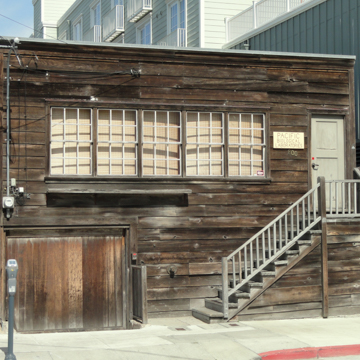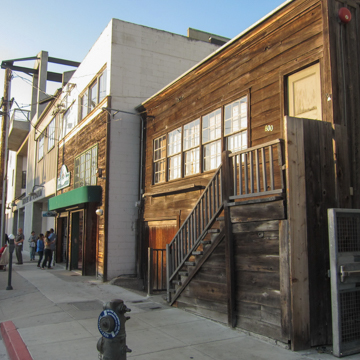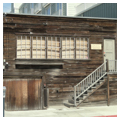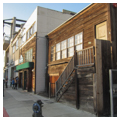You are here
Pacific Biological Laboratory
This two-story, wood-frame building on the bay side of Cannery Row functioned as the laboratory of Edward Flanders Robb Ricketts (1897–1948), a marine biologist and ecologist as well as author. Ricketts professional success, however, was eclipsed by his immortalization as the character “Doc” in John Steinbeck’s novels, Cannery Row (1945) and Sweet Thursday (1954).
Built in 1937 by a local carpenter, this structure replaced an earlier residential building destroyed by the Del Mar Canning Company fire in November 1936. The rough-sawn board-and-batten building has a rectangular footprint and a facade clad in shiplap siding with edge boards at the corners. A simple crown molding creates a subtle transition for the flat roof that slightly slopes towards the rear elevation, which is fenestrated and opens directly onto the bay. The facade is marked by a garage opening on the ground level and an open staircase that leads to the second-story entrance. Five contiguous double-hung windows are the only other feature on the Cannery Row elevation.
By the time Ricketts moved to the Monterey area with his wife in 1922, there was already a marine laboratory in existence. In 1892, the first marine laboratory on the west coast was established by gift of Timothy Hopkins in neighboring Pacific Grove. In 1923, Ricketts founded Pacific Biological Laboratories with his college colleague, Albert E. Galigher, in the same locale. Within two years, Ricketts was the sole proprietor of the biological supply house through which he collected aquatic specimens that he sold to museums and universities around the world. In 1928, Ricketts relocated the business to 740 Ocean View Avenue, to a house formerly occupied by the Rodriguez family. Between its construction and 1932, the laboratory served not only as an office and, following his separation from his wife, Ricketts’ dwelling, but also a social nexus for the area’s writers, artists, and scientists. Following Ricketts’ premature death, colleagues and friends continued to use the lab as a gathering place for weekly meetings. The City of Monterey acquired the structure in 1993. It was restored by the Cannery Row Foundation, earning the Governor’s Award for Historic Preservation, and subsequently opened to the public.
References
Architectural Resources Group. “Final Cannery Row Cultural Resources Survey Report Document.” Prepared for the City of Monterey, California, 2001.
Writing Credits
If SAH Archipedia has been useful to you, please consider supporting it.
SAH Archipedia tells the story of the United States through its buildings, landscapes, and cities. This freely available resource empowers the public with authoritative knowledge that deepens their understanding and appreciation of the built environment. But the Society of Architectural Historians, which created SAH Archipedia with University of Virginia Press, needs your support to maintain the high-caliber research, writing, photography, cartography, editing, design, and programming that make SAH Archipedia a trusted online resource available to all who value the history of place, heritage tourism, and learning.

















